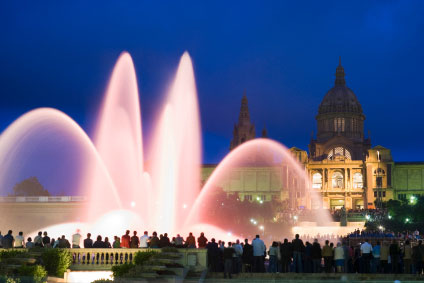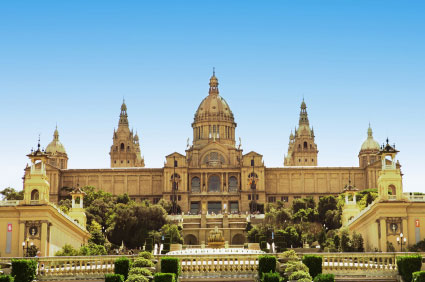
Montju´c Mountain - Montju´c Mountain information and pictures
| Tweet |
Montju´c Mountain is an ancient Roman hill that majestically rises up from the Plaša d'Espanya. Filled with attractions originally built for the 1929 Universal Exhibition and the 1992 Olympics, Itĺs a popular destination for both locals and tourists and is a must- see, if not for the view alone. Visitors can take a scenic funicular train to the top, or take the metro to the Plaša d'Espanya and proceed to walk from there along beautiful terraces, with the help of outdoor escalators.
The Mountainĺs attractions consist of scenic botanical gardens, the 1992 Olympic Ring and facilities, a popular Spanish village constructed as a tourist site in 1929 and a Military Museum in an 18th century castle, to name a few. However, the main attractions are the stunning Palau Nacional, a resplendent palace built as the focal point for the 1929 Exhibition and the Font Magica or Magic Fountain that graces the front of the palace.
Palau Nacional - Architects, Enric CatalÓ and Pedro Cendoya, designed the Palau Nacional in a decidedly Baroque style. It dominates the top of Montju´c Mountain and is adorned with all the customary palace type flourishes of statues, urns and sculptures.
It now houses the Museu Nacional d'Art de Catalunya, which has an extensive permanent collection of 11th century Romanesque church paintings, as well as 16th century Renaissance art and 13th century Gothic pieces. Modern art from the 19th and early 20th centuries such as, Picassoĺs Hat and Fur Collar are also displayed.
Magic Fountain - Engineer Carles Buigas built the Magic Fountain to adorn the front of the Palau Nacional. His fountain project begins at the Plaša d'Espanya where he lined the avenue leading up to the Palace with 50 gushing fountains. The cascading fountains lead to the main draw; the enormous Magic Fountain that is equipped with colored lights and hundreds of gushing jets spraying water into the air.
In the evenings, a spectacular, free light show is put on accompanied to music selections from Mozart, Bach and even Star Wars. The brightly colored cascades and streams of water, dance in tune to the music providing a highly entertaining and beautiful spectacle. The show takes place in the summer months throughout the evening until midnight on Thursday through Sunday and on Friday and Saturday in the winter. The Magic Fountain show is a special attraction, unique to Barcelona that is not to be missed.
The Mies van der Rohe Pavilion serves as the early standard for the spare, modern school of architecture and design that emerged during the turn of the 20th century. The original Pavilion was built as Germanyĺs site for the 1929 Barcelona International Exhibition, by cutting edge German architect, Ludwig Mies van der Rohe.
During the course of the Exhibition, the unique Pavilion with its open space plan and use of natural materials such as, onyx and travertine made a huge impact in the field of architecture. Miesĺ iconic leather chair, designed specifically for the Pavilion, became known as the ôBarcelona chairĺ and remains popular to this day.
Pavilion Reconstruction - When the Exhibition ended, the Pavilion was taken down after no buyers appeared to purchase it intact. Over the years, the Pavilion became a focal point of modern architecture and reproductions of the Barcelona chair became immensely popular. Because of its architectural importance, the Barcelona City Council restored the Pavilion in 1986 to its original location on Montju´c Mountain, using identical materials and design.
The Pavilion is now a popular attraction in this Catalan city with a passion for architecture. The Mies van der Rohe Pavilion is also used for architectural conferences and exhibits. The original leather Barcelona chairs and stools designed and constructed by Mies van der Rohe are on display.
Pavilion Design - A team of Spanish architects utilized the same organic materials of polished marble, green travertine, onyx and tinted glass to create a spacious interior with no corners and seemingly floating, free standing stone walls. With the use of a reflecting pool and courtyard to reflect light and a reproduction of the delicate, sculpture by Georg Kolbe, the restored Pavilion is a study in serenity. Visitors can tour the interior and view Miesĺ innovative design of natural stone and tinted glass that sparked a revolution in modern design.

Magic Fountain
Where is Mies van der Rohe Pavilion: Avinguda MarquŔs De Comillas, Montju´c
How to get to Montju´c: By Subway Line 1, 3 to Espanya Station
Opening Hours for Mies van der Rohe Pavilion: Daily from 10 AM to 8 PM

Palau Nacional, Barcelona
Please help us build a better site. Add your comments about Montju´c Mountain here.

Barcelona Attractions
Copyright © GoThereGuide.com 2015
All rights reserved.
All rights reserved.
User Comments about Montju´c Mountain